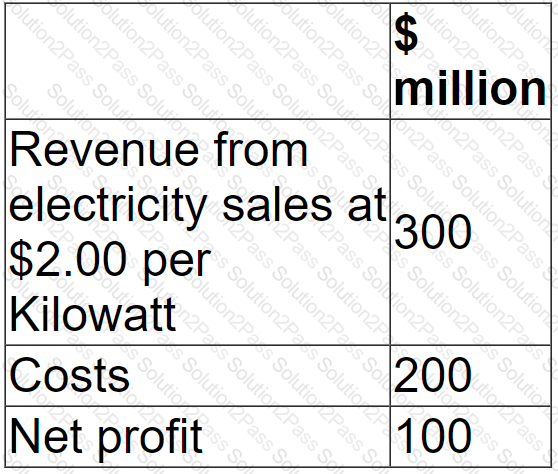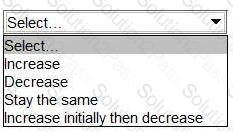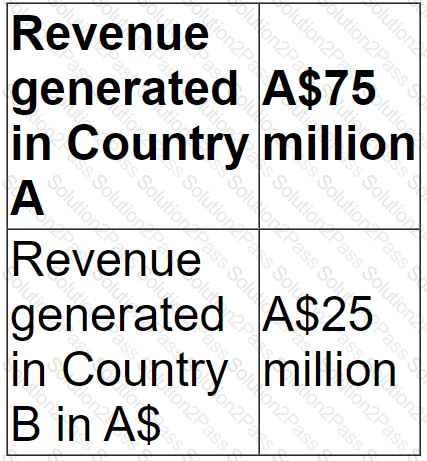F3 CIMA Financial Strategy Free Practice Exam Questions (2025 Updated)
Prepare effectively for your CIMA F3 Financial Strategy certification with our extensive collection of free, high-quality practice questions. Each question is designed to mirror the actual exam format and objectives, complete with comprehensive answers and detailed explanations. Our materials are regularly updated for 2025, ensuring you have the most current resources to build confidence and succeed on your first attempt.
An unlisted company is attempting to value its equity using the dividend valuation model.
Relevant information is as follows:
• A dividend of $500,000 has just been paid.
• Dividend growth of 8% is expected for the foreseeable future.
• Earnings growth of 6% is expected for the foreseeable future.
• The cost of equity of a proxy listed company is 15%.
• The risk premium required due to the company being unlisted is 3%.
The calculation that has been performed is as follows:
Equity value = $540,000 / (0.18 - 0.08) = $5,400,000
What is the fault with the calculation that has been performed?
A publicly funded school is focused on providing Value for Money
It pays its leaching staff less than other schools, because class sizes are generally smaller than elsewhere Despite some staff demotivation from low pay, exam pass rates are high given the close one-to-one attention many pupils receive.
On which aspect of Value for Money is the school underperforming?
Company MB is in negotiations to acquire the entire share capital of Company BBA. Information about each company is as follows:

It is expected that Company BBA's profit before interest and tax will be $30 million in each of the two years after acquisition. Company AAB is considering how best to structure the offer Company AAB's discount factor and appropriate cost of equity for use in valuing Company BBA is 10%
Shareholders taxation implications should be ignored
Which of the following provides the shareholders of Company BBA with the highest offer price?
Listed company R is in the process of making a cash offer for the equity of unlisted company S.
Company R has a market capitalisation of $200 million and a price/earnings ratio of 10.
Company S has a market capitalisation of $50 million and earnings of $7 million.
Company R intends to offer $60 million and expects to be able to realise synergistic benefits of $20 million by combining the two businesses. This estimate excludes the estimated $8 million cost of integrating the two businesses.
Which of the following figures need to be used when calculating the value of the combined entity in $ millions?
A company generates and distributes electricity and gas to households and businesses.
Forecast results for the next financial year are as follows:

The Industry Regulator has announced a new price cap of $1.50 per Kilowatt.
The company expects this to cause consumption to rise by 10% but costs would remained unaltered.
The price cap is expected to cause the company's net profit to fall to:
Company AEE has a 10 year 6% corporate bond in issue which has a nominal value of $400 million, which is currently trading at 95%. The bond is secured on the company's property
The Board of Directors has calculated the equity value of Company AEE as follows;

Which THREE of the following are errors in the valuation?
A listed company is planning a share repurchase.
The following data applies:
• There are 10 million shares in issue
• The share repurchase will involve buying back 20% of the shares at a price of $0.75
• The company is holding $2 million cash
• Earnings for the current year ended are $2 million
The Directors are concerned about the impact that this repurchase programme will have on the company's cash balance and current year earnings per share (EPS) ratio.
Advise the directors which of the following statements is correct?
Which THREE of the following statements are disadvantages of the net asset basis of valuation?
A listed company is planning a share repurchase.
The following data applies
• There are 20 million shares in issue
• The share repurchase will involve buying back 10% of the shares at a price of $1.20
• The company is holding $4.8 million cash
• Earnings for the current year ended are $3.6 million
The Directors are concerned about the impact that this repurchase programme will have on the company's cash balance and current year earnings per share (EPS) ratio.
Advise the directors which of the following statements is correct?
PTT has a number of subsidiary companies around the world, including FTT based in Europe and CTT based in Indonesia
CTT purchases all of us raw materials from FTT CTT processes these materials and the resulting products are exported to several different countries CTT pays FTT in the Indonesian currency.
Indonesia's inflation is higher than that of FTTs home country
Which of the following statements are correct?
Select ALL that apply
PPP's home currency is the PS. An overseas customer is due to make a payment of A$5,000,000 to PPP in 3 months. The present spot rate is 1PS = 5A$. P can obtain an interest rate of 4% per year on P$ deposits and 6% per year on AS deposits.
Forecast the value of the customer's payment to PPP, in PS, when the payment is made in 3 months' time.
Give your answer to the nearest thousand PS.

A company has in a 5% corporate bond in issue on which there are two loan covenants.
• Interest cover must not fall below 3 times
• Retained earnings for the year must not fall below $3.5 million
The Company has 200 million shares in issue.
The most recent dividend per share was $0.04.
The Company intends increasing dividends by 10% next year.
Financial projections for next year are as follows:
Advise the Board of Directors which of the following will be the status of compliance with the loan covenants next year?
A listed company has recently announced a profit warning.
The company's share price fell 20% on the day of the announcement but had been fairly static in the weeks leading up to the announcement.
Which form of efficient market is most likely to be indicated by this share price movement?
A company is undertaking a lease-or-buy evaluation, using the post-tax cost of bank borrowing as the discount rate.
Details of the two alternatives are as follows:
Buy option:
• To be financed by a bank loan
• Tax depreciation allowances are available on a reducing-balance basis
• Assets depreciated on a straight-line basis
Lease option:
• Finance lease
• Maintenance to be paid by the lessee
• Tax relief available on interest payments and book depreciation
Which THREE of the following are relevant cashflows in the lease-or-buy appraisal?
Company GDD plans to acquire Company HGG, an unlisted company which has been in business for 3 years.
Company HGG has incurred losses in its first 3 years but is expected to become highly profitable in the near future
There are no listed companies in the country operating in the same business field as Company HGG The future success of Company HGG's business and hence the future growth rate in earnings and dividends is difficult to determine
Company GDD is assessing the validity of using the dividend growth method to value Company HGG
Which THREE of the following are weaknesses of using the dividend growth model to value an unlisted company such as Company HGG?
Which of the following statements is true of a spin-off (or demerger)?
A company's directors plan to increase gearing to come in line with the industry average of 40%. They need to know what the effect will be on the company's WACC.
According to traditional theory of gearing the WACC is most likely to:

Using the CAPM, the expected return for a company is 10%. The market return is 7% and the risk free rate is 1%.
What does the beta factor used in this calculation indicate about the risk of the company?
A company based in Country D, whose currency is the D$, has an objective of maintaining an operating profit margin of at least 10% each year.
Relevant data:
• The company makes sales to Country E whose currency is the E$. It also makes sales to Country F whose currency is the F$.
• All purchases are from Country G whose currency is the G$.
• The settlement of all transactions is in the currency of the customer or supplier.
Which of the following changes would be most likely to help the company achieve its objective?
Company X is based in Country A, whose currency is the A$.
It trades with customers in Country B, whose currency is the B$.
Company X aims to maintain its revenue from exports to Country B at 25% of total revenue.
Company A has the following forecast revenue:

The forecast revenue from Country B has assumed an exchange rate of A$1/B$2, that is A$1 = B$2.
If the B$ depreciates against the A$ by 10%, the ratio of revenue generated from Country B as a percentage of total revenue will:


